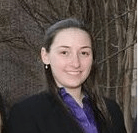
By KERRY WORTHINGTON, Leaders in Energy Reporter
On January 20, 2016 Leaders in Energy once again teamed up with Potential Energy DC, this time to bring a panel of local government representatives to discuss green financing programs in their jurisdictions. On the panel were Rich Dooley, Community Energy Coordinator from the Arlington County Department of Environmental Services; Bill Updike, Chief of Green Building & Climate Branch from the DC Department of Energy and Environment (DOEE); and Michelle Vigen, Senior Energy Planner with the Montgomery County (Maryland) Department of Environmental Protection.
After a thirty minute networking session, Dave McCarthy of Potential Energy DC welcomed the guests to the TeqCorner building, thanked the night’s sponsors, Ernst & Young, and gave an introduction to the evening’s event as well as to Janine Finnell of Leaders in Energy. Dave also mentioned that PEDC will soon celebrate their one year anniversary with 17 members, and they are looking to double their membership in 2016.
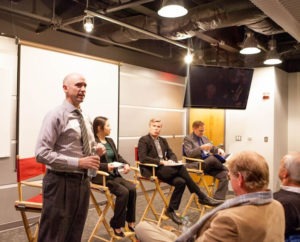

(L: Dave McCarthy, Potential Energy DC; R: Janine Finnell, Leaders in Energy)
Janine energized the audience, beginning with an overview of the purpose of Leaders in Energy − to connect change leaders to enable sustainable solutions. Janine mentioned a recent event at the Carnegie Endowment for International Peace featuring a panel discussing the newly released United Nations Environmental Programme (UNEP) Inquiry on “Aligning the Financial System with Sustainable Development.” The report highlights the need to integrate sustainable factors into the financial system to enable the transition to a low carbon, green economy, which is aligned with our event’s theme on “Green Financing.”
She also gave a shout out on the upcoming Friday, Feb. 5th, Leaders in Energy’s “Energy and Sustainability Extravaganza” at the George Mason University (GMU) campus in Arlington. The Extravaganza will include a Women in Energy and Environmental Leadership Luncheon Panel, with experts in solar, bioenergy, nuclear, and sustainability, and a Showcase with professors from GMU discussing their clean energy and sustainability education and research programs, and Professional Mixer. Click here for more information.
Without further ado, Dave introduced the panelists.
Montgomery County and Green Banking
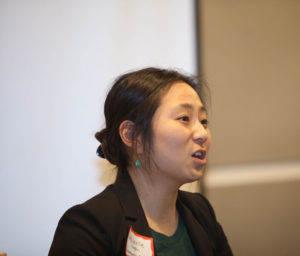
Michelle was proud to say that Montgomery County was the first county in the nation to pass a law to establish a Green Bank. The Green Bank seeks to support and enhance private sector financing for clean energy projects. By partnering with private capital providers, the Green Bank can expand the capital industry’s experience with clean energy investments and help develop a market, not unlike what we commonly experience with the broad availability of a car loan or home mortgage. Montgomery County’s Green Bank effort enjoys the generous assistance and support from the nonprofit Coalition for Green Capital, workgroup experts, and technical assistance partners. They are currently conducting a market assessment to identify the gaps and niches to see where the greatest financing opportunities are to drive clean energy investment.
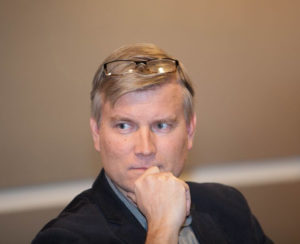
Michelle also spoke about other County programs and policies, such as their Benchmarking Law, requiring building owners to disclose how much energy they use and rewarding building owners for their efficiency investments. Montgomery County also has a Commercial Property Assessed Clean Energy (PACE) financing program, to help building owners access capital for energy improvements.
Initiatives in the District of Columbia
Bill is really proud of the impressive and proactive policy legacy of DC as well as the region. Along with other firsts, DC was the first city to pass a law requiring green building certification for both the public and private sectors and the first to pass a law requiring energy and water benchmarking of buildings. DC passed its first Renewable Portfolio Standard in 2005 and then added a special carve out for local solar in 2011 that has created some of the best financials for solar in the nation. Recently, the DC metro area passed Los Angeles for the most ENERGY STAR certified buildings in the nation. This policy legacy and leadership from the private sector has led to a number of firsts in DC—the city has more LEED certified projects and ENERGY STAR certified buildings on a per capita basis than any other city in the U.S.
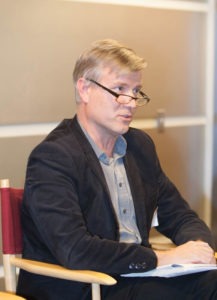
But Bill mentioned that there is a lot more work to do. In DC, only about 830 of the 126,000 buildings in the city are LEED certified, representing 115 million of the 730 million square feet in the District. And even then, LEED and the Energy Star programs are just the start of the bigger challenge to reach at least zero net impact and the ultimate goal of a net positive impact on people and the planet.
Funding for energy efficiency originally was undertaken by the regulated utilities, but that system was not working well, so the city created the DC Sustainable Energy Utility, which is structured to have the flexibility of an entity outside of the District government, while still allowing the DC DOEE to have oversight. DC has also created a commercial PACE energy and water financing program, and now is looking into the possibility of creating a residential PACE program.
DC is currently ranked in the top five for solar financing in the country. Bill mentioned that in addition to the environmental attributes, property owners should think of their solar arrays as mutual funds sitting up on their roofs, earning them 40%+ returns on investments and paying themselves back in less than five years, and in some cases less than three years. Recently, DC signed the largest wind and onsite solar power purchase agreements (PPA) of any city government in U.S. history. Collectively, those deals with save the city $70 million over 20 years. Other initiatives include an industrial revenue bond program, an annual commitment of $100 million dollars to support affordable housing, efforts to support the Living Building Challenge, tax credit structures that suit both policies and financial structures. However, Bill believes these are just scratching the surface of true sustainability.
Arlington and the Re-Think Energy Program
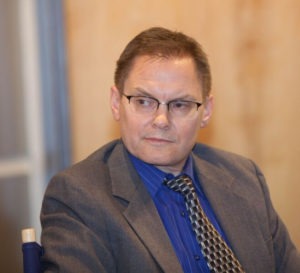
Arlington adopted a community energy plan out to 2050 in June 2015 that focused on three pillars: (a) economic competitiveness; (b) energy resilience and security; and (c) increasing environmental commitment. Rich highlighted that the challenge is to make the economics work and evolve the program as market conditions change. Arlington has a green building density incentive program, a commercial lighting rebate program, plans to participate in the PACE (in fact they have an RFP out for a program administrator).
Following brief remarks from Rich, Dave asked the audience for questions.
Utility and Consumer Relationships
The question was: “how are these government entities getting utilities to be involved with deep retrofits of existing buildings, and getting utilities to cooperate with consumers to be a part of the future of energy?”
Bill answered first and mentioned that DC is fairly unique since it is a city with its own Public Service Commission. DC has an open docket for grid modernization that will provide the framework for a 21st century grid network in the city. Admittedly, there is no magic bullet, despite the various research and analysis efforts nationwide. But initiatives like the Green Bank, net zero energy projects, and grid modernization offer huge opportunities to solve this industry challenge.
Are there any specific funding opportunities?
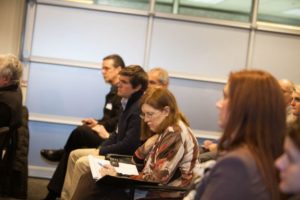 DC is currently analyzing where the best place for early deployment of microgrids will be in the city, and looking at legislative, policy, and financing solutions to support microgrids; all of which will be rolled into the grid modernization docket.
DC is currently analyzing where the best place for early deployment of microgrids will be in the city, and looking at legislative, policy, and financing solutions to support microgrids; all of which will be rolled into the grid modernization docket.
Arlington currently has 100 passive house projects in the county and one net zero elementary school. Rich sees opportunity in educating the public on those success stories, developing case studies, and identifying lessons learned for future projects. Arlington has also noticed that projects were not being analyzed for energy efficiency until the project was already 58% through, which resulted in developers concluding that energy efficiency was too expensive. The best time to analyze for energy efficiency is at the beginning of the project. That appears to be a common theme in Arlington, as Vincent Verweij Forrester of Arlington County noted during Leaders in Energy’s October 8, 2015 Urban Sustainability event that the best time to plan for environmental development is at the beginning stages of projects.
DC has been putting sustainability language into RFPs for development parcels in the city and is now getting responses with net positive energy proposals. As Bill put it “if you build it, they will come.”
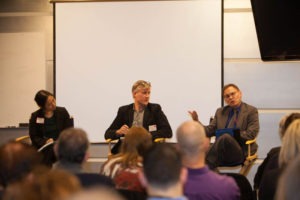
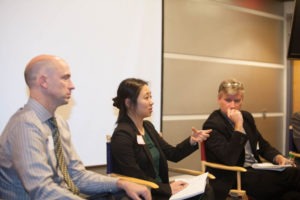
After a follow up question on industrial revenue bonds, the panelists explained that there are vehicles that the District can back. The PACE programs have the ability to tap into revenue bond structures.
Net energy imports versus production
DC currently exports $1.2 billion for the purchase of fossil fueled based energy outside of DC borders. There was a brief discussion of how local universities were purchasing renewable power from North Carolina and lighthearted commentary on the actual physics of the location of the grid.
How does risk assessment on new technologies influence financing structures?
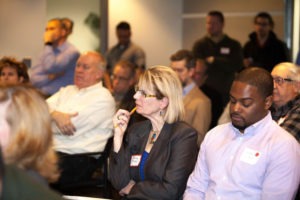 Michelle noted that the Montgomery County’s financing efforts are currently focused on addressing gaps in established but under-deployed energy efficiency strategies, such as their application in multifamily or small commercial buildings. She noted that they have looked into the U.S. Department of Energy’s loan guarantee program for implementing innovative technologies that need a little more support to get to commercialization. According to Bill, the alternative compliance payments for the Renewable Portfolio Standard in DC have the potential to provide a funding path for emerging technologies; however, this year it is being used for low income solar installations. Arlington is learning from energy reduction startups that are being applied for the military, and Rich is optimistic that the private sector will follow suit.
Michelle noted that the Montgomery County’s financing efforts are currently focused on addressing gaps in established but under-deployed energy efficiency strategies, such as their application in multifamily or small commercial buildings. She noted that they have looked into the U.S. Department of Energy’s loan guarantee program for implementing innovative technologies that need a little more support to get to commercialization. According to Bill, the alternative compliance payments for the Renewable Portfolio Standard in DC have the potential to provide a funding path for emerging technologies; however, this year it is being used for low income solar installations. Arlington is learning from energy reduction startups that are being applied for the military, and Rich is optimistic that the private sector will follow suit.
Communication with credit agencies on revenue bonds and credit enhancements
An audience member claimed that credit agencies refuse to acknowledge the benefit energy efficiency and renewable energy provide to balance sheets and asked how jurisdictions are encouraging credit agencies to back energy programs. In DC, there is an industrial bond program, although they have not used it for energy efficiency yet. Bill agreed that there is a challenge to getting banks to believe in the investment; however, he remains optimistic about the future.
Montgomery County is exploring other vehicles for supporting programs. For example, the Green Bank might explore guaranteeing a certain portion of a private investor’s loan. These programs can be structured where the creditor may take the first hit, and the Green Bank would take the second (such as a similar program in Connecticut). One barrier to broader investment is that data on risk is not currently readily available for these types of energy improvements. The Green Bank is well positioned to address the needs of investors, identify market developments, and where appropriate, provide a guarantee or some type of assurance to spur investment.
One of the five recommendations from a Climate Change and Resilience Report from the Virginia Governor’s Office, out on December 31, 2015, is to establish a new Virginia bank. Rich suspects that this Bank could facilitate a green bank program or credit enhancements for energy projects around the state and hopes that it positively affects the initiatives at the Arlington County level as well.
After another audience question, Michelle addressed what the Green Bank looked like for the individual on the ground. Despite the term “bank”, its role is market development, not necessarily consumer lending, she says. Green banks aim to determine where the market gaps are, where investment is needed, and where the deepest need is for financial resources. For example, Montgomery County has identified that it needs approximately $3 billion to meet its energy and climate policy goals, not to mention those of the rest of the state of Maryland. Leveraging other programs, like the commercial PACE program, the bank would build a community of partners in the industry and private capital industry to make valuable investments.
Energy-Water Nexus
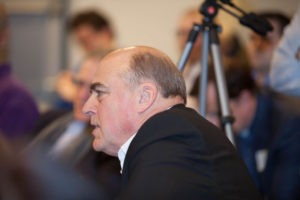 An audience member prompted a discussion on large energy consumers – namely, water treatment facilities – and challenged the panelists as to why there is not more organization at the local governmental levels to address those interdependencies. Cities around the world are catching on to the fact that there are many opportunities to be net energy positive. Rich stated that the Arlington County and community energy plan applies to the water systems as well; that everyone is rowing towards the same goals. Bill noted that it costs about a penny of energy per gallon to process water in the city, and when the city is processing hundreds of millions of gallons of water on an average day, the energy costs are no joke, and there are efficiencies to be gained. Additionally, DC Water is doing some research on sewer heat recovery. Another challenge is to have inter-agency leadership. Michelle underscored that water infrastructure and consumption is an important issue; that water costs are rising faster than electricity prices, even though we may not notice since the costs of water are so low.
An audience member prompted a discussion on large energy consumers – namely, water treatment facilities – and challenged the panelists as to why there is not more organization at the local governmental levels to address those interdependencies. Cities around the world are catching on to the fact that there are many opportunities to be net energy positive. Rich stated that the Arlington County and community energy plan applies to the water systems as well; that everyone is rowing towards the same goals. Bill noted that it costs about a penny of energy per gallon to process water in the city, and when the city is processing hundreds of millions of gallons of water on an average day, the energy costs are no joke, and there are efficiencies to be gained. Additionally, DC Water is doing some research on sewer heat recovery. Another challenge is to have inter-agency leadership. Michelle underscored that water infrastructure and consumption is an important issue; that water costs are rising faster than electricity prices, even though we may not notice since the costs of water are so low.
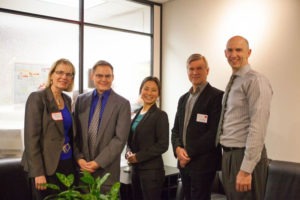
Global Perspectives and Local Focus
Many in the audience followed up with Michelle, Bill, and Rich directly during the pizza and networking time. Personally, this event opened my eyes to all of the techniques that local governments are trying to implement to bring sustainability to their communities. It is laudable that this event maintained its local focus while having many professionals in the room that have global perspectives and aspirations as well. Sometimes I get caught up in the big picture of state and federal policies, but, like Michelle said, we need to maintain a local perspective. A top-down and bottom-up approach is necessary to effect the change that we want to see in these communities. The three pillars that guided the Arlington community plan that Rich spoke of are really at the forefront of decision makers’ minds at the national and global level, and it was a new experience for me for those to be applied at the community level.
Reflecting on what Michelle said about data needs, I also thought back to the Leaders in Energy Smart Cities event, where we learned about opportunities for synergies between data and energy is right over the horizon – if not already here in some places. Bill’s point about inter-agency leadership in the water-energy nexus reminded me of the The Evolving Bioeconomy and Renewable Fuels. The theme of inter-agency collaboration in biofuels, and in the President’s Clean Power Plan, is a trend that will not go away, as we realize the interconnectedness of these industries and the synergies that can speed up progress.
Photos courtesy of Agustín Cruz – augie.cruz@gmail.com.


Leave a Reply